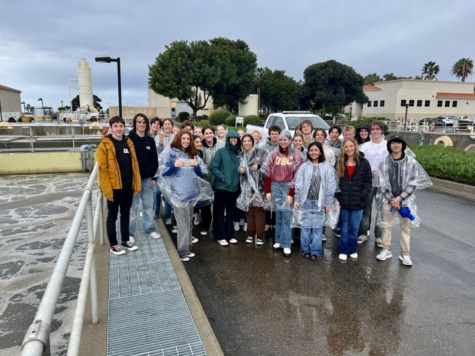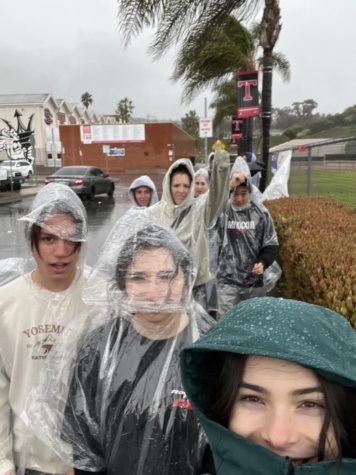
Amanda Dirpes | Writer
March 3, 2023
Last Tuesday and Wednesday, AP Environmental Science students said “goodbye” to February, or “hello” to March by venturing on a tour of the San Clemente Water Reclamation Plant, in order to learn more about how their wastewater is processed.
The journey to the water sanitization plant was, ironically, wet. Students trekked nearly a mile in the wind and rain, donning stylish plastic ponchos provided by their teacher, Mr. Rasor. Soaked, but smiling, the trip was educational and enriching.

“I learned a lot about the different stages of recycling water on the trip, and my soaked socks definitely reminded me of our tour throughout the day,” senior Malia Petrocelli jested.
The San Clemente Water Reclamation Plant’s state-of-the-art facilities play a vital role in the region’s water management. Designed to treat wastewater, the plant renews and recycles flushes and drainage into high-quality recycled water which can be used for various purposes, including irrigation, industrial processes, and groundwater recharge.
The city built the facility in response to the region’s growing demand for water and need for reduced dependence on imported water. Construction was completed in 2004, and it has been operating ever since, treating an average of 3.5 million gallons of wastewater per day.
“I had no idea our city goes through that much water on a daily basis! Reducing the amount of water we use is super important because of the perpetual drought in California, and this statistic really put that into perspective for me,” senior Brandon Malone expressed.
The plant employs an advanced treatment process that involves multiple stages of filtration, disinfection, and polishing. The process’s first stage is the preliminary treatment, which removes large solids and debris, also known as inorganic grit) from the wastewater. Primary settling then allows heavier organic solids to sink. A treatment called aeration, or activated sludge, then combines biological and chemical processes which remove organic matter and nutrients, such as nitrogen and phosphorus. The final stage of the process is the tertiary filtration, which applies advanced microfiltration using sand to produce high-quality recycled water.
The recycled water produced by the San Clemente Water Reclamation Plant is of such high quality that it exceeds the state’s standards for irrigation and industrial uses. The plant has a dedicated pipeline that delivers the recycled water to nearby golf courses, parks, and other public spaces for irrigation purposes. In addition, the plant has partnered with local industries, such as a nearby power plant, to provide them with recycled water for their cooling processes. All filtered water that is not recycled is sent through a pipeline which lets out into the ocean approximately a mile off the shore.
The San Clemente Water Reclamation Plant exemplifies how modern wastewater treatment technology aids in meeting the water demands of a growing population, while reducing the pressure on the region’s natural water sources. The plant’s innovative approach to water management is not only environmentally friendly, but it also contributes to the economic development of the region by providing a reliable source of recycled water to industries and businesses. Both of which are fundamental concepts in an AP Environmental class, making it the perfect destination for a convenient field trip.

i remember having to drive past this to get home and it smells horrible
let’s eat activated sludge together